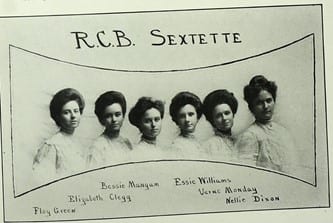This post was written by Benna Vaughan, Assistant Librarian, Special Collections & Manuscripts Archivist


The Laura Wise Maverick papers, consisting of a scrapbook, diary, and travel journal, are now open for research at The Texas Collection. Though the Maverick name has long been associated with Texas and her growth (Laura’s grandfather, Samuel Augustus Maverick, was a land baron and signer of the Texas Declaration of Independence, her father a rancher and prominent developer of San Antonio), Laura would make her name on the stage as a contralto, touring throughout the United States and Canada, and performing with the Metropolitan Orchestra and the Russian Symphony Orchestra.
Laura was born on November 22, 1878 in San Antonio, Texas, to William H. Maverick and Emilia Virginia Chilton Maverick. Growing up on a ranch allowed Laura free reign for her adventurous spirit and she was often seen on the back of a horse riding at full speed around the grounds. She attended St. Mary’s Hall Episcopal school and graduated from the San Antonio High School for Young Ladies in May of 1895. She then attended Wheaton Female Seminary in Norton, Massachusetts. Sources differ as to the exact year of her marriage to Dr. Amos Lawson Graves, but the couple wed on April 19th in the early 1890s. They had two children, Amos Maverick and Laura Maverick. They couple would later divorce, with Laura and the children moving to New York to pursue her career in music. She trained abroad in the ensuing years with noted instructors, and by 1911, was making a name for herself in New York and Texas music circles.
On January 28, 1912, Laura appeared with the Russian Symphony Orchestra in Carnegie Hall. The New York Press said of her performance:
She was received with many manifestations of approval. Miss Maverick is a mezzo-
contralto of pleasing personality and sings with taste and intelligence. Her voice has
exceptional purity and quality and her diction in three languages was admirable, as
well as her phrasing and intonation.

Laura toured and performed throughout the United States and Canada, taking a summer off during 1912 for time at her ranch in Texas. It was during this time that Laura went to Mexico where she devoted weeks to the study of Mexican songs. She also married cellist and conductor Carl Hahn in 1912, and they would tour and perform together in the following years. The couple would later divorce. They had no children.

The scrapbook in the Maverick papers covers Laura’s musical career during the years of 1911-1913. Programs, repertoire lists, press releases, announcements, and news clippings are prominent throughout. The last clipping remarks on the passing of Laura’s mother and brother, within a week of each other (1913), and mentions the cancellation of Laura’s tour for that year. Loose materials within the scrapbook include photographs and personal mementos. The travel journal contains the month and day of each entry but not the year. It speaks of an early U.S. tour and reflects on the places she visited, events attended, and modes of travel. A letter from her granddaughter in 1954 is also found with the journal. The diary picks up later in Laura’s life from 1933-1937, with many entries discussing children, family, friends, colleagues, and life on the road. A poem inscribed in the front of her diary seems to echo her outlook: “Smile a smile/ While you smile/ Another smiles/ And soon there’s miles and miles of smiles/ And life’s worthwhile/ If you just smile.” (credited to Jane Thompson)
The Laura Wise Maverick papers offer an interesting facet of the Maverick family history, through a glimpse of the life of one of its female members. Rich and elegant in tone, the papers reflect the influence of music in society during the early 1900s, and the life of women working in music and theater.
Citations
Laura Wise Maverick papers, Accession #663, Box 1, Folder 3, The Texas Collection, Baylor University
“Laura Maverick as an Amateur Circus Rider,” Musical America, December 23, 1912 (Scrapbook)
“Laura Maverick,” Music (Boston) January 27, 1912 (Scrapbook)
Find A Grave, Inc. “Laura Wise Maverick.” Memorial #134173414. Accessed 2012 April 26.






